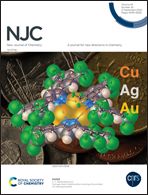Fabrication of novel CuAgZnSnSe4–Cu2ZnSnSe4 thin film solar cells by the vacuum evaporation method†
Abstract
CuAgZnSnSe4 (CAZTSe) thin film solar cells were fabricated on various conducting substrates (Al, Cu, Ag, FTO, and AZO). Initially, non-commercial conducting substrates (Al, Cu, and Ag) were fabricated by the vacuum evaporation method. Then, CAZTSe thin films were deposited on non-commercial and commercial conducting substrates (FTO and AZO) by the vacuum evaporation method. The structural, morphological, optical, and electrical properties of the films were studied by various analytical techniques. XRD analysis showed tetragonal-structured CAZTSe films for the films deposited on commercial and non-commercial conducting substrates; the Raman spectra showed the presence of impurity phases for all the films. The crystallite size was found to be varied with respect to the substrates, and the films deposited on glass and Cu substrate had a size of 100 nm. The SEM image of the deposited films showed a spherical-shaped morphology. The optical property of the films deposited on various conducting substrate showed higher optical absorption in the visible region with an absorption coefficient of 104 cm−1. The band gap of the CAZTSe films was in the range 1.514–1.893 eV. Mott–Schottky plots revealed n-type conductivity for all the films and the carrier concentration was in the range 1018–1019 cm−3. Heterojunction solar cells were fabricated with the structure glass/X/CAZTSe/CZTSe/Ag (X = Al, Cu, Ag, FTO, and AZO) and their photoconversion efficiencies were studied and compared with earlier reports.



 Please wait while we load your content...
Please wait while we load your content...